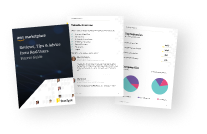
Overview
Sigma is the first native cloud data warehouse (CDW) analytics and business intelligence (A&BI) solution that empowers anyone - yes, anyone - to securely access and analyze real-time data to make insight-driven decisions and find the answers they need to revolutionize their business. Trusted by data-driven companies, Sigma provides direct, live access to CDWs (e.g. Redshift, Snowflake) via the Sigma Spreadsheet interface without ever moving data out of the CDW, allowing security, governance, and compliance to be centrally enforced. Sigma is the Single Source of Truth for data throughout an organization because any work (e.g. data sets, modeling, analysis) done in Sigma can be written back to the CDW and leveraged in any other internal or external application or system.
The Sigma Spreadsheet empowers anyone to create complex data analysis without ever writing a single line of code while SQL is automatically generated under the hood, freeing analysts and data teams to focus on more complex, innovative projects. The familiar, easy-to-use interface transforms the A&BI process by eliminating the need to change the data model as more questions are asked and making data exploration an iterative process. Sigma enables a community-driven approach to A&BI because work can be securely shared, collaborated on, and built upon by others throughout the organization.
Highlights
- Knowing SQL is optional with Sigma because every action taken in the Sigma Spreadsheet is automatically written in SQL under the hood so anyone in the organization can analyze data and create visualizations, reports, and dashboards.
- Sigma sits directly on top of a CDW, enabling anyone in the organization to explore and analyze data without ever removing data from the CDW, which ensures security, governance, and compliance.
- Sigma is the Single Source of Truth for data throughout an organization because any work (e.g. data sets, modeling, analysis) done in Sigma can be written back to the CDW and leveraged in any other internal or external application or system.
Details
Introducing multi-product solutions
You can now purchase comprehensive solutions tailored to use cases and industries.

Features and programs
Trust Center

Buyer guide

Financing for AWS Marketplace purchases

Pricing
Dimension | Description | Cost/12 months |
|---|---|---|
14-day Free Trial | Free Trial with 5 Maximum Users | $0.00 |
Enterprise Platform | Enterprise Platform + 24/7 Enterprise Support | $150,000.00 |
Add On - Creator | Admin access, create joins, worksheets, dashboards, write back | $2,000.00 |
Add On - Explorer | Drill down dashboard to worksheet & data sets (curated by Creators) | $2,000.00 |
Add On - Viewer | Interactive Dashboards w/ filtering capabilities | $0.00 |
Vendor refund policy
Please contact Support@sigmacomputing.com if you have concerns about refunds
How can we make this page better?

Legal
Vendor terms and conditions
Content disclaimer
Delivery details
Software as a Service (SaaS)
SaaS delivers cloud-based software applications directly to customers over the internet. You can access these applications through a subscription model. You will pay recurring monthly usage fees through your AWS bill, while AWS handles deployment and infrastructure management, ensuring scalability, reliability, and seamless integration with other AWS services.
Resources
Vendor resources
Support
Vendor support
Sigma offers real-time support in the product & can also be reached at Support@sigmacomputing.com
AWS infrastructure support
AWS Support is a one-on-one, fast-response support channel that is staffed 24x7x365 with experienced and technical support engineers. The service helps customers of all sizes and technical abilities to successfully utilize the products and features provided by Amazon Web Services.



Standard contract
Customer reviews
Effective Performance Tracking with Slight Delays
Reporting dashboards have streamlined tracking and decision-making but present a steep learning curve
What is our primary use case?
My main use case for Sigma is that there are a bunch of reports, and many of our main reports are built on Sigma . I use it as a dashboard, review the reports, filter through there, and use it to help make decisions.
A quick specific example of a report or dashboard I use in Sigma that helps me make decisions is that it lists the number of reviews that we have gotten for a certain product or a certain campaign, and I can reuse that in my marketing to say that we have done X amount of whatever. It is mainly a reporting dashboard that I use for keeping track of certain things.
What is most valuable?
Sigma offers the ability to pull a lot of data, and I think the filtering is pretty good.
The filtering feature in Sigma helps me because you can get pretty in-depth, and I just appreciate it because you are able to drill down on whatever you are looking at.
Sigma has positively impacted my organization because I think it has been a huge impact, and we use it for all our reporting and our dashboards for tracking. It is a really big, integral part of our company.
What needs improvement?
I think Sigma can be improved because, for the last ten months since I first started here, this is my first time ever using it, and I think there is a steep learning curve. It is not as intuitive as I was hoping, so once you figure it out and get going, it is easy to use, but I would say at the very beginning, the learning experience is kind of hard.
For how long have I used the solution?
I have been using Sigma for ten months.
What do I think about the stability of the solution?
Sigma is stable from what I have seen.
What do I think about the scalability of the solution?
Sigma's scalability is nice because everybody on the team has access and uses it, and it is nice that permissions are easily set as well, so you only get to see what you need to see and you can share what needs to be shared.
How are customer service and support?
I have not had to use customer support, so I cannot rate the customer support on a scale of one to ten.
How would you rate customer service and support?
Negative
Which solution did I use previously and why did I switch?
I did not previously use a different solution before Sigma.
How was the initial setup?
I manage user access and permissions within Sigma, and that process is very easy.
What about the implementation team?
I stay updated with new features or updates in Sigma, but I am not personally involved in that. I do not receive any notifications about that.
What was our ROI?
I have definitely seen a return on investment through time saving because once the dashboards are built, they are built. Once we get them built, you are able to share with whoever needs them, so you get live data, and it has been a huge time saver.
What's my experience with pricing, setup cost, and licensing?
I do not know much about my experience with pricing, setup cost, and licensing because I am not heavily involved in that.
Which other solutions did I evaluate?
We did not evaluate other options before choosing Sigma.
What other advice do I have?
My advice to others looking into using Sigma is to take the time to learn how to set it up at the get-go and understand that there is a learning curve. I would rate this review a seven out of ten.
Empowers Data Analysis with Spreadsheet Ease and Scalability
Why I like Sigma
Analyzing user return visits and accessing program data has become significantly faster
What is our primary use case?
My main use case for Sigma is to check on the status of our accounts, my accounts, and my programs. I love using a tool where I can analyze the return visits of leads that we've already sent to customers.
I use Sigma for analyzing those return visits by loading it, setting the fields for a particular account of mine, and I can see the leads that we've sent. In analyzing, I let Sigma do its magic and can run another report that tells me every time one of those lead accounts has returned to PeerSpot to continue their research. This has been an invaluable resource for me to share with some of our customers to help them understand the value of our audience in showing how their leads are continuing to visit and do their research, which provides our customers with great intelligence for their account scoring and lead handling.
I'm using Sigma to check on all the programs. That was one of my favorite use cases, but to see how many leads have been delivered, to see how many reviews have been collected, to see how many review interviews have been set up, how our outreach center is contacting prospects for leaving reviews. There are a lot of different use cases for Sigma.
What is most valuable?
Having those dashboards set up in Sigma has made things easier for me and my team because it's just going into one report. There are a couple of different tabs in the same report rather than opening multiple different dashboards and reports from Salesforce , and that just speeds things up and saves some time.
Sigma has positively affected my organization by saving us time in accessing information, which ultimately gets us to complete projects faster.
I understand the value and would say I get through tasks 25% faster using Sigma.
What needs improvement?
Sigma can be improved in terms of speed; it would be great if it could process the data even faster. I think it's more of our use of it that I'm not responsible for in getting the Salesforce data into Sigma. Sometimes I can't find what I need or the data isn't quite uploaded correctly, but I think it's a problem of the entry into Salesforce, not getting it over to Sigma. It would be nice if the reports also included more graphics and were more visually pleasing or compelling rather than just data.
For how long have I used the solution?
We started using Sigma as a company about a year and a half ago.
What do I think about the stability of the solution?
I think Sigma is stable.
How are customer service and support?
I haven't used customer support at all.
How would you rate customer service and support?
Neutral
Which solution did I use previously and why did I switch?
Before Sigma, we used a different solution, but I don't remember what it was called. I wasn't involved in the decision to make the switch, so it's irrelevant. Sigma is a good choice.
What was our ROI?
I have seen a return on investment with Sigma; we already said that it saves about a quarter, it gets me to answers about 25% faster.
What's my experience with pricing, setup cost, and licensing?
When it comes to pricing, setup cost, and licensing, it has nothing to do with me.
Which other solutions did I evaluate?
I don't know if my team evaluated other options before choosing Sigma.
What other advice do I have?
I'm not doing any customization with Sigma. The ease of use is there. It takes a little while just to get used to it. Sometimes when I'm running an estimate for leads, in my haste, I try to get the answers, but I need to wait for it to finish processing all the data, which is totally reasonable. But it's pretty easy to use.
My advice for others looking into using Sigma is to make sure you set up the reports and the dashboards in the most efficient way. Ask for feedback from your teams if multiple people are going to be using it. Because once it's set up, it's a very powerful tool. But if not all the perfect data is in there, then it's just not going to do its job.
On a scale of one to ten, I rate Sigma an eight.